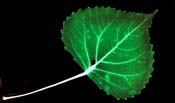IMAGINE
CROCODILES creeping under palm trees in Wyoming. Imagine a North
Pole with no year-round ice, where forests of tall trees grow
above the Arctic circle. Imagine tropical plants thriving outdoors
in London and Midwestern winters no colder than comfortably
cool.
These conditions actually existed on Earth.
Several million years after the mass extinction that claimed
the dinosaurs, another curious worldwide phenomenon took place
-- the late Paleocene and early Eocene epochs sustained temperatures
as high as 8 degrees warmer than present-day conditions over
a period of 5 million years. What's more, winters in continental
interiors were surprisingly mild, even for a globally warm period.
Paleontologists know about the warm winters
of 55 million years ago because they have found fossil ancestors
of crocodiles and palms -- which cannot tolerate cold weather
-- in continental interiors at midlatitudes. Scott Wing, a paleobotanist
at the Smithsonian Institution's National Museum of Natural
History, has spent two decades unearthing plant fossils from
this time period in the badlands of Wyoming. These findings
raised a deep question about climate: how did the winters stay
temperate so far from the oceans? In today's climate, the interiors
of continents at midlatitudes get cold in the winter since they
have short days and long nights and lie far from the warming
ocean.
"Lawrence, Kansas doesn't give a darn about
what the oceans are doing," UC Santa Cruz paleoclimate modeler
Lisa Sloan says. She wondered: did the ocean's stabilizing influence
somehow reach farther inland in warmer times? Not likely, she
answered in a 1990 paper.
Sloan and colleague Eric Barron's computer
model showed that even during globally warm periods, winters
in continental interiors should have been cold, far colder than
crocodiles and palm trees could stand. Either something was
wrong with their model -- painstakingly constructed to simulate
today's climate conditions -- or Wing and other paleontologists
had somehow misread their fossils. In short, the notion of Wyoming's
warm winters left Sloan cold.
Her conclusion startled fossil hunters. Many
insisted the computer model was simply wrong.
next
>>







